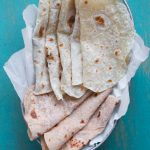
Easy Chapati/Roti/Phulka (Indian Flat Bread)
Servings: 10 pieces
Calories: 103kcal
Learn how to make Indian-style unleavened flat bread or known as chapati with this easy recipe. The dough can be made with whole wheat flour or all-purpose flour if you don't have Atta flour.
Print Recipe
Ingredients
- 230 gr Atta flour , or substitute white wheat flour or all-purpose flour, sifted, plus extra for rolling
- 1 tsp salt
- 2 Tbsp vegetable oil or ghee (clarified butter) and more for cooking the bread
- 170 gr hot water start with 130 gr if using all-purpose flour
Instructions
- Whisk together flour and salt. Add the hot water and oil and use a spatula to stir at first. The dough won't come together just yet. When it's cool enough to handle, use your hands to knead the dough into a soft, slightly, sticky dough
- Transfer this to a work surface, dusted with some flour. Give the dough a few kneads until you get a smooth dough, about 1 minute
- Divide the dough into 8-10 pieces (depending on how large you want the chapati to be) and shape into balls. Keep them covered and rest for 15 minutes
- Dust some flour on your work surface, dust your palm and rolling pin with flour, and flatten each ball with your palm. Use a rolling pin to roll from the center outward with light strokes and rotate the bread slightly between each stroke, until it is 7 to 8 inches in diameter. You want to roll the dough thin
- Set aside and repeat with the remaining dough. Do not stack the rolled-out chapati; if you don't have enough counter space for them all, roll out just a few and begin cooking, then roll out the others as the chapati cooks
Cooking:
- Heat a cast-iron griddle or skillet over medium-high heat. When the griddle is hot, put about 1/2 tsp of oil or ghee and spread it over the surface. Place a chapati top side down on the griddle and let it cook for only 10 to 15 seconds, then gently flip to the second side. Cook on the second side until small bubbles begin to form in the dough and there are some light brown spots, approximately 1 minute
- Flip the chapati again and gently press on the surface using a clean towel or rubber spatula. A perfect chapati will puff up. Flip again and cook for another 30 seconds or so. If the chapati start to burn on the bottom before it has ballooned, move the bread across the skillet, dislodging it from the point at which it is beginning to burn
- When you are happy with your chapati, remove it and brush with some oil/butter/ghee and wrap in a clean towel. Cook the other chapati, stacking each as it is finished on top of the others and wrapping the stack in cloth to keep the chapati soft and warm
How to store:
- Let chapati cools down at room temperature and then wrap with a cling wrap. They can be stored at room temperature for 2-3 days if it's not humid, otherwise, keep them in the refrigerator
- For longer storage, keep them in the freezer and simply thaw at room temperature and then reheat on the stove until warm and soft again
Nutrition
Serving: 1chapati | Calories: 103kcal | Carbohydrates: 17g | Protein: 3g | Fat: 3g | Saturated Fat: 1g | Polyunsaturated Fat: 1g | Monounsaturated Fat: 2g | Trans Fat: 1g | Sodium: 236mg | Potassium: 84mg | Fiber: 2g | Sugar: 1g | Vitamin A: 2IU | Calcium: 8mg | Iron: 1mg